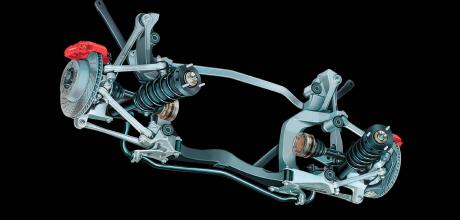Porsche 911 993 multi-link rear suspension

The 993’s multi-link rear suspension brought more than just improved comfort, says Alisdair Cusick
In addition to marking the end of the air-cooled era, the 993 introduced one standout development: its multilink rear axle suspension. For the first time, the rear axle of a 911 was capable of steering inputs.
The origins of the technology date back to 1977 with the 928. Until then, rear suspension was commonly a semi-trailing arm setup, whereby two arms connect to the body with two rubber bushes. Imagine driving a right-hand bend at speed with this system, then snap decelerating. Because of deflection in the rubber bushes under load, the outside wheel will toe-out, and the inside wheel will toein. The net result is that the rear of the car steers into an oversteer condition.
The phenomenon was widely understood in the motoring industry from the 1950s, but Porsche worked on a solution. In the 1970s, lacking modern computer power, that development was rather more low-key and hands-on. 928 suspension was cobbled to an Opel Admiral, with the addition of a second steering wheel for an engineer to apply steering input at the rear. It was quickly realised that some rear toe-in, when applied quickly, stabilised handling in dynamic driving. The resulting system they designed for the 928 was the Weissach Axle – a method of passively steering the rear. By using elasto-kinetic suspension elements, under deceleration a wheel could be made to automatically toe-in, rather than out, thereby taming a tendency for oversteer.
The 993 saw Porsche achieve the full potential of that ‘Weissach effect’ axle. A redesigned multi-link lightweight, stable, agile (LSA) rear end is mounted to a diecast alloy subframe, with two upper and two lower suspension arms, all rigidly mounted. A fifth arm, joining the leading lower arm to the subframe, is designed to give under load, achieving toe correction through the arc of suspension travel. Thus, driving our imaginary right-hand corner, under load, a 993 rear suspension will self-correct to toe-in on the outside rear wheel and toe-out on the inside rear wheel. The net result is a reduced tendency to naturally oversteer when lifting off, but besides this more predictable handling, ride was less harsh, cabin noise is reduced, and stability under braking is improved.
Porsche itself states the 993’s LSA rear end as being “instrumental in finally putting an end to the capriciousness of the rear-engine-powered 911.” A bold statement indeed.

